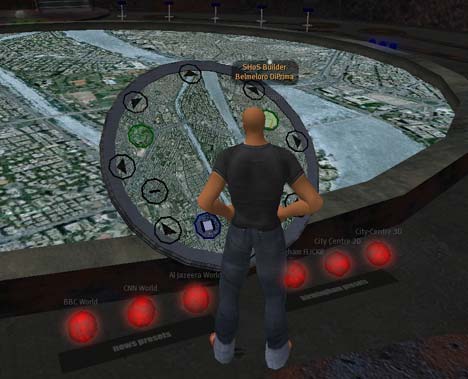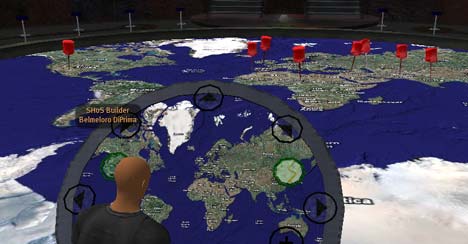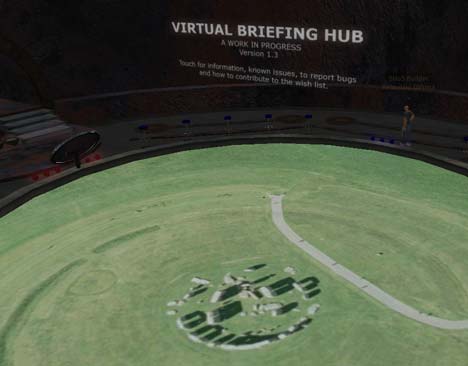- Pachube: This has the makings of something brilliant. Make Blog points to Pachube, a geo-savvy aggregator and browser of sensor data to which you can add your own data streams or use others’ as input for your own projects. The sensor web’s domain even includes virtual worlds like Second Life. Do read the about page for much more info. With a compatible Arduino sensor device costing around US$35 these days, I may have to put up a decibel meter outside my apartment in Cairo:-)
- Web Google Earth for Dokuwiki: Dokuwiki is a wiki app for the web “aimed at small companies’ documentation needs” with a “simple but powerul syntax” that can be extended by plugins. One such plugin, by Chris Smith, lets you add Google Maps instances to your wiki. Martin Meggle-Freund of Munich has noticed that with the release of the Google Earth API extension to Google Maps, you can now change the type parameter to “Earth” to get browser based Google Earth instances. He makes good use of it on his kmlwiki.net site, where anyone can add, annotate and edit maps and 3D views. Edit a page and look at the markup code to see how easy it is.
- PDF to KML: Tech-savvy phylogenist Roderic Page over at iPhylo does the sort of thing that one day, in a far-off fully semantic future, we will look back at and chuckle: Extracting location data from a PDF and returning it as a KML file.
- Doppler does GeoNames: The first and last place I look when I really, really have to find an obscure placename’s location is not Google but GeoNames. Now trip planning aggregator Dopplr has begun using GeoNames data, which is available to all under a Creative Commons License, so now I can start visiting really out-of-the-way places:-) (And their integration with Yahoo!’s FireEagle makes a lot of sense. I only really want to update my trip plans once, and everybody else should just talk amongst themselves.)
- New (old) blog: Henri Willox, who often used to find and post great new neogeo content on his Blogue du LFG (Guadalajara, Mexico) before disappearing, has popped up again, this time in Conakry, Guinea, with a new blog: Le Technoblog du LAC. Update your newsreaders (if you understand French).
- Google Earth spam alert: Some of the Google Adsense ads on this blog and others are weird: They advertise Google Earth but aren’t from Google. I used to think the game was to attract surfers via cheap cost-per-click adwords, only to show them a website with ads for high cost-per-click adwords, and then pocket the difference. But Joe Wein comes across a new reason for these ads: some lead to sites that sell “subscriptions” for what is actually a free product to gullible and unaware surfers.
- Solar KML layer, anyone? Dean Ervik, manager of renewable energy projects at Australia’s EcoWorld, is looking for a KML layer that can show “global (or Australian) solar irradiation or radiation onto the Earth’s surface that may or may not be animated across a year (or uses an ephemeris).” If such a layer does not exist, he’d be up for paying a KML developer to make one. I think there are some interesting visualization opportunities here. Contact details on ecoworld.com.au.
- Tom Tom has Nav app for iPhone: MacNN has a spokesman for Tom Tom confirming that the company has a prototype GPS navigation program running for the iPhone, and that he does not think Apple’s iPhone SDK’s terms of use prohibit such an application… but he isn’t sure. You’d think they’d contact Apple and find out:-)
- JSKML: JSKML “is a simple translator to translate KML input into the JSKML format or an identical format in JSON notation if that is what you need.” Because sometimes, you need to access content in a KML file via javascript. By EarthBrowser’s Matt Giger.
- Kenya roads: Google’s Ed Parsons points us to news that the results of the Google-sponsored Kenya mapping project are now available on Google Maps. The road- and point-of-interest mapping project was completed by seven local university students, together with a team from India, presumably the one that is responsible for a similar project in India.
Given that such technology has the potential to transform the well-being of locals not previously privy to free online and mobile maps, I hope Google open-sources the data, so that other valuable group mapping projects, such as Tracks4Africa and OpenStreetMap.org, don’t end up duplicating efforts, and so that the data gets the widest possible exposure. After all, Tracks4Africa is in Google Earth; why not return the favor? (Currently, the new Kenya road layer is not yet in Google Earth — when it is, we’ll be able to compare them.)
- Google Maps in Second Life: Second Life developers Daden Limited have played with Google Maps before… but now they’ve taken advantage of a relatively new feature in Second Life to create a intriguing collective map viewing tool. In Second Life you can now use a website as a texture for an item such as a screen; Daden have created a Google Maps page controlled via the API, and then linked controls in Second Life to the map via the API to change the map view. Everyone nearby sees the same map, to which you can add geoRSS feeds. One featured suggested use is a quiz game, where contestants have to be the first to identify the landmark in the zoomed-in satellite imagery. That could become addictive. (Via Not Possible IRL, which (mistakenly) ascribes the above to the Google Earth API.)



Hmm Gmaps in 2nd life is that legal?
I’m not always sure if an API is used properly, but in this case I am. Daden is merely displaying a certain web page on a screen in SL, and the content for that web page has been acquired via a legal use of the Google Maps API. Anybody could choose to display any web page in Second Life — what Linden Lab has done is develop a web browser for their virtual world.
Is there a link to this in Second Life? If its on Daden’s island I can’t find it.
Thanks
Rich
For Solar radiation in Europe, see
http://re.jrc.ec.europa.eu/pvgis/apps3/pvest.php?address=berne#
br, Marcel
There is a link in the post to the SLUrl.
Tom Tom’s Nav application GPS I think will be better than Apple’s own.